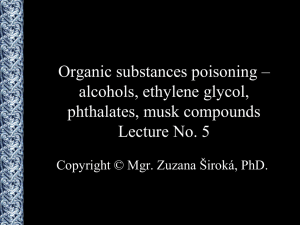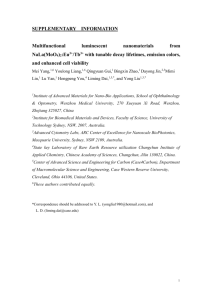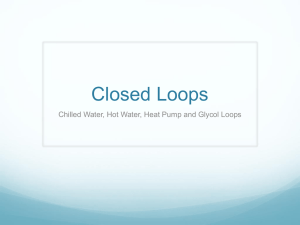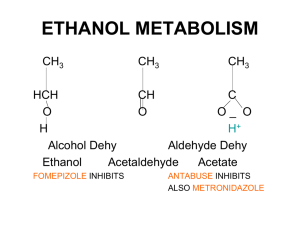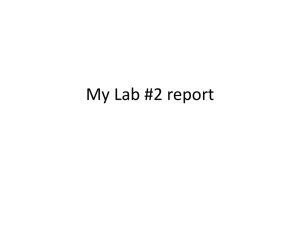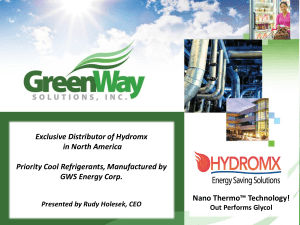Cleaning and Chemical Treatment of Glycol Systems
advertisement
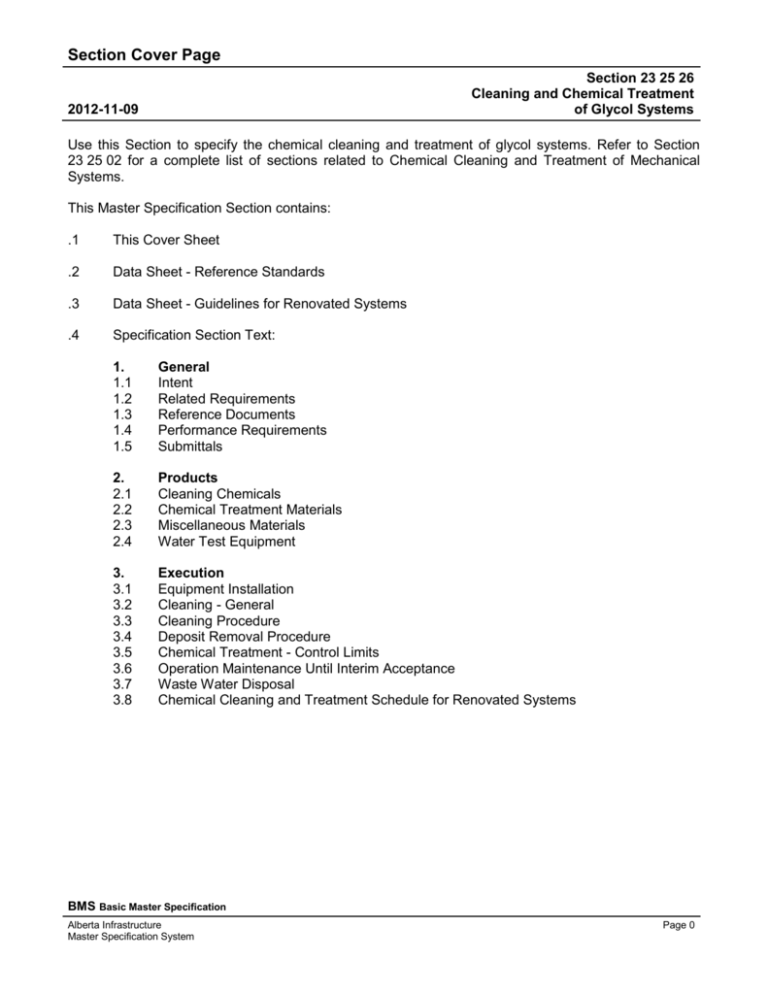
Section Cover Page Section 23 25 26 Cleaning and Chemical Treatment of Glycol Systems 2012-11-09 Use this Section to specify the chemical cleaning and treatment of glycol systems. Refer to Section 23 25 02 for a complete list of sections related to Chemical Cleaning and Treatment of Mechanical Systems. This Master Specification Section contains: .1 This Cover Sheet .2 Data Sheet - Reference Standards .3 Data Sheet - Guidelines for Renovated Systems .4 Specification Section Text: 1. 1.1 1.2 1.3 1.4 1.5 General Intent Related Requirements Reference Documents Performance Requirements Submittals 2. 2.1 2.2 2.3 2.4 Products Cleaning Chemicals Chemical Treatment Materials Miscellaneous Materials Water Test Equipment 3. 3.1 3.2 3.3 3.4 3.5 3.6 3.7 3.8 Execution Equipment Installation Cleaning - General Cleaning Procedure Deposit Removal Procedure Chemical Treatment - Control Limits Operation Maintenance Until Interim Acceptance Waste Water Disposal Chemical Cleaning and Treatment Schedule for Renovated Systems BMS Basic Master Specification Alberta Infrastructure Master Specification System Page 0 Data Sheet - Guidelines for Renovated Systems Section 23 25 26 Cleaning and Chemical Treatment of Glycol Systems 2012-11-09 1. When any of the following work has been performed, no cleaning is required but loose deposits must be flushed out before flooding with system glycol. .1 .2 .3 .4 2. New piping which can be isolated from the rest of the system: .1 .2 3. .3 Clean the deposits from the entire system as specified in 2.1.2 and 3.4. Clean the entire system with the chemical cleaner and procedure specified in 2.1.1 and 3.3. Chemically treat the entire system with the old or fresh glycol specified in 2.2 and 3.5. Fire-tube boilers where more than approximately 50% of the tubes in are re-placed: .1 .2 .3 .3 .4 5. Clean piping using the chemical cleaner and procedure specified in 2.1.1 and 3.3. Chemically treat the entire system with glycol specified in 2.2 and 3.5. New piping which can not be isolated from the rest of the system: .1 .2 4. A minor amount of new piping is added to the system when compared with the entire system. Fin-tube boiler is re-tubed. Less than approximately 50% of the tubes are replaced in a fire-tube boiler. Chiller or converter is re-tubed. Isolate the boiler from the rest of the system. Drain or collect the glycol from the boiler. Clean the deposits from the boiler as specified in 2.1.2 and 3.4. Clean the boiler with the chemical cleaner and procedure specified in 2.1.1 and 3.3. Chemically treat the boiler with a corrosion inhibitor specified in 2.2 and 3.5. Removal of deposits from system/boiler where no new piping is added or re-tubing is done: .1 .2 Clean the deposits from the system/boiler as specified in 2.1.2 and 3.4. Chemically treat the system/boiler with old or fresh glycol specified in 2.2 and 3.5. END OF DATA SHEETS BMS Basic Master Specification Alberta Infrastructure Master Specification System Page 0 Section 23 25 26 Cleaning and Chemical Treatment of Glycol Systems Page 1 Plan No: Project ID: 1. General 1.1 INTENT .1 1.2 This Section specifies services and material required for onsite, cleaning and chemical treatment of a multi-metal, closed loop [glycol heating system] glycol water system]. RELATED REQUIREMENTS .1 .2 .3 1.3 Mechanical Spare Parts and Maintenance Materials: Chemical Treatment and Cleaning Equipment: Chemical Treatment and Cleaning - General Requirements: Section 20 00 23. Section 23 25 01. Section 23 25 02. REFERENCE DOCUMENTS .1 .2 American Society for Testing and Materials (ASTM): .1 ASTM D1121-07 Standard Test Method for Reserve Alkalinity of Engine Coolants and Anti-rusts .2 ASTM D2688-05 Standard Test Method for Corrosivity of Water in the Absence of Heat Transfer (Weight Loss Methods) Alberta Infrastructure Documents: .1 1.4 Alberta Infrastructure Water Treatment Program Manual PERFORMANCE REQUIREMENTS .1 Cleaning activities shall remove oil, grease, silt, and rust from system. Cleaned metal surfaces shall be well passivated. .2 Ensure that chemical treatment is capable of maintaining operation performance standards as follows: Parameter Control Limits Suspended solids: Iron Corrosion Rate: Nil. Stable rate, 0.5 mils per year maximum, no pitting. Stable rate, 0.2 mils per year maximum, no pitting. 0.5 mg/L Fe maximum. 0.2 mg/L Cu maximum. Copper Corrosion Rate: Total Iron Concentration: Total Copper Concentration: 2012-11-09 BMS Version Section 23 25 26 Cleaning and Chemical Treatment of Glycol Systems Page 2 Plan No: Project ID: 1.5 SUBMITTALS .1 In addition to submittal requirements specified in Section 23 25 02, submit a written report of actual cleaning activities including: .1 .2 .3 .4 .5 .6 .7 .8 .9 .10 .11 .12 .13 .14 .15 Times. System status. Problems encountered. Actions taken. Composition of cleaning & spent cleaning solutions. Type of glycol or manufacturer’s brand name of glycol added to system. Inspection results. Final glycol concentration. Final pH level. Final reserve alkalinity based on 100% glycol. Final suspended solids concentration. Final iron concentration. Corrosion coupon weights. Corrosion rates. Final Iron and Copper concentration. 2. Products 2.1 CLEANING CHEMICALS SPEC NOTE Inside surfaces of glycol system components must not be galvanized. .1 Cleaning Solution: neutral pH cleaning solution which is capable of removing oil, grease, and rust from metal surfaces of system and passivating cleaned metal surfaces of system. Cleaning solution shall include: .1 .2 .3 .4 .5 Low foaming non-ionic surfactant for penetrating oily and greasy deposit surfaces. Solvent for dissolving oil and grease. Dispersant for dissolving rust. Reducing agent for corrosion control. Ferrous and non-ferrous metal corrosion inhibitors. SPEC NOTE: Specify deposit removal cleaning solution for existing systems. .2 2012-11-09 BMS Version Deposit Removal Cleaning Solution: blended neutral pH cleaning solution which is capable of removing scale and iron deposits, destroying bacteria, and passivating metal surfaces of system. Section 23 25 26 Cleaning and Chemical Treatment of Glycol Systems Page 3 Plan No: Project ID: 2.2 CHEMICAL TREATMENT MATERIALS SPEC NOTES: for Glycol Automotive grade and recreational vehicle grade glycol are not acceptable. Glycol must be industrial grade. Heating Systems require: 50% volume ethylene or 52% volume propylene glycol. Cooling systems which are in operation year round require 50% volume ethylene or 52% volume propylene glycol. Cooling systems in which the total systems are inside the building and are shutdown during the winter months require 30% volume ethylene or 35% volume propylene glycol, otherwise 50% volume ethylene or 52% volume propylene glycol. Where there is a concern that the glycol may be ingested accidentally or purposely use propylene glycol, otherwise use ethylene glycol. A corrosion inhibitor consisting of food grade dipotassium hydrogen phosphate must be present in ethylene and propylene glycol systems. Ethylene and propylene glycol must not be mixed in the same system. For existing systems specify the same type of glycol that is in the system. .1 Glycol: pre-mixed [inhibited industrial grade 50% volume ethylene glycol][inhibited industrial grade 30% volume ethylene glycol][inhibited industrial grade 52% volume propylene glycol][inhibited industrial grade 35% volume propylene glycol]. .1 2.3 Ethylene glycol used must be available with a separate corrosion inhibitor component to restore corrosion inhibitor properties. MISCELLANEOUS MATERIALS .1 Corrosion Coupons: Will be supplied and installed by the Minister. .2 By-pass Filter Cartridge: sized between 5 and 20 microns, for retention of particles greater than 20 microns in diameter. 2.4 WATER TEST EQUIPMENT .1 Supply one of each of the following water test kits specified in Section 23 25 02: .1 2012-11-09 BMS Version pH test kit. Section 23 25 26 Cleaning and Chemical Treatment of Glycol Systems Page 4 Plan No: Project ID: 3. Execution 3.1 EQUIPMENT INSTALLATION .1 Prior to performing chemical treatment work ensure following work specified in Section 23 25 02 has been completed: .1 .2 .3 3.2 Sample cooler - for heating systems only. By-pass filter and flow indicator device. Corrosion coupon rack as per detail drawing 23 25 01 01. CLEANING - GENERAL .1 3.3 Maintain following conditions during cleaning process: .1 Manual and automatic valves are in full open position. .2 By-pass valves are operated to ensure full flow through entire system. .3 Safety devices, including pressure relief valves, flow switches, and pressure switches are functioning. .4 System is operated with a minimum pressure of 35 kPa(g) at highest point and expansion tank level is maintained at 1/3 to 1/2 full of water. .5 Fine mesh strainers for system pump and control valve strainer baskets are cleaned as required. CLEANING PROCEDURE .1 Step 1: Fill system with domestic water, establish circulation, and heat system contents to a temperature of 60°C. .2 Step 2: After two hours of circulation, collect water samples from at least three different locations in system. If these samples contain suspended solids, clean out strainer baskets, drain system, and repeat steps 1 & 2. .3 Step 3: Blend in prepared concentration cleaning solution, established circulation, and maintain system temperature at 60°C for at least three days. .4 Step 4: Dump spent cleaning solution to disposal, fill system with domestic water, circulate system contents for at least two hours, and dump spent rinse water to disposal. .5 Step 5: Fill system with domestic water and repeat step 4 until water samples collected from system are free of oil, grease, and suspended solids. 2012-11-09 BMS Version Section 23 25 26 Cleaning and Chemical Treatment of Glycol Systems Page 5 Plan No: Project ID: .6 Step 6: Drain system completely, including all system low points and perform visual inspections of metal surfaces at three different locations. .7 Complete steps 4, 5 & 6 with in a 24 hour period. .8 If metal surfaces contain oil, grease or silt, fill system with domestic water and repeat steps 3, 4, 5 & 6. .9 Immediately after inspection is completed, install filter cartridge and fill system with pre-mixed glycol, and pass system glycol through by-pass filter and corrosion coupon rack. SPEC NOTE: Specify deposit removal procedure for cleaning of existing systems. 3.4 DEPOSIT REMOVAL PROCEDURE .1 Step 1: Fill system with domestic water, establish circulation, and heat system contents to a temperature of 60°C; .2 Step 2: Blend in prepared concentrated cleaning solution for removal of deposits etc., establish circulation, and maintain system temperature at 60°C until total iron concentration stabilizes; .3 Step 3: Dump spent cleaning solution to disposal, fill system with domestic water, circulate system contents for at least two hours, and drain spent rinse water from various locations in system to disposal; .4 Step 4: Fill system with domestic water and repeat step 3 until water samples collected from system are free of suspended material; .5 Step 5: Drain system and perform visual inspections of metal surfaces at three different locations; .6 Complete steps 3, 4, & 5 within a 24 hour period. .7 Step 6: If metal surfaces contain scale or iron deposits and are not passivated, fill system with domestic water and repeat steps 2, 3, 4 & 5. 2012-11-09 BMS Version Section 23 25 26 Cleaning and Chemical Treatment of Glycol Systems Page 6 Plan No: Project ID: 3.5 CHEMICAL TREATMENT - CONTROL LIMITS .1 Maintain control limits specified in following schedule: Type or Glycol Ethylene Glycol glycol concentration, % vol: pH at 25°C: reserve alkalinity based on 100% glycol: Propylene Glycol glycol concentration, % vol: pH at 25°C: reserve alkalinity based on 100% glycol: .2 3.6 Heating System and Cooling Systems (Exposed to Outside Temperatures) Cooling System (Not Exposed to Outside Temperatures) 50 ±2 8.5 minimum 30-35 8.5 minimum 9.0 minimum 9.0 minimum 52 ±2 8.5 minimum 35-40 8.5 minimum 9.0 minimum 9.0 minimum Test for reserve alkalinity in accordance with ASTM D1121. 100% glycol reserve alkalinity value is equal to reserve alkalinity value times 100 divided by glycol concentration. OPERATION MAINTENANCE UNTIL INTERIM ACCEPTANCE .1 Perform following minimum routine maintenance until Interim Acceptance of the Work: .1 Maintain control limits specified under "Performance Requirements" and "Chemical Treatment - Control Limits". .2 Replacing fouled filter cartridges in by-pass filter with new filter cartridges as required to maintain continuous flow through filter. .3 Test glycol samples of system monthly for following: .1 .2 .3 .4 .5 .6 .4 2012-11-09 BMS Version Visual appearance. pH level. Glycol concentration. Reserve alkalinity concentration based on 100% glycol. Suspended solids concentration. Iron and copper concentration. Document glycol analyses results on a chemical treatment report form. Section 23 25 26 Cleaning and Chemical Treatment of Glycol Systems Page 7 Plan No: Project ID: .2 3.7 Document glycol analyses results and any corrosion inhibitor added on a chemical treatment report form. WASTE WATER DISPOSAL .1 3.8 Wastewater discharged into a municipal sanitary sewer system from existing or new systems shall be within the limits established by local authorities. Where no local limits have been established, stay within limits specified in “Alberta Infrastructure Water Treatment Program Manual, Section I - Environmental Guideline”. CHEMICAL CLEANING AND TREATMENT SCHEDULE FOR RENOVATED SYSTEMS SPEC NOTE Schedule cleaning requirements for renovated glycol systems based on the guidelines on Page 01. .1 Clean and treat renovated glycol systems as follows: .1 Re-tubed fin-tube boiler or heat exchanger: .1 .2 New piping - isolated from rest of system: .1 .2 .3 Flush out loose deposits before flooding with system water. Chemically clean piping. Chemically treat entire system with corrosion inhibitor. [ .1 .2 .3 ]: [ [ [ END OF SECTION 2012-11-09 BMS Version ]. ]. ].


